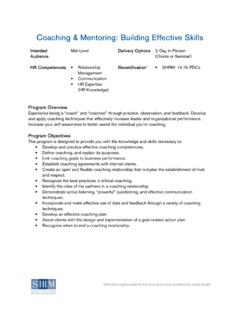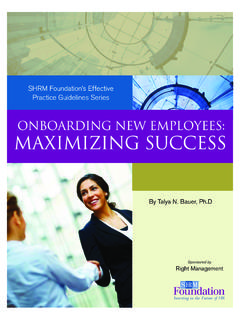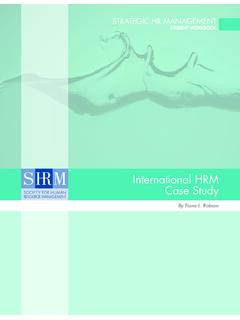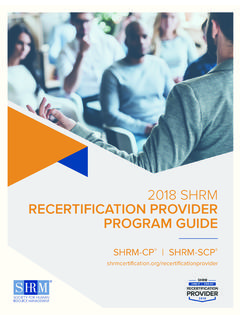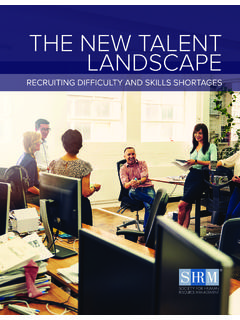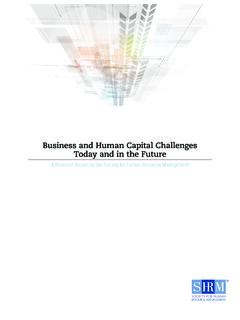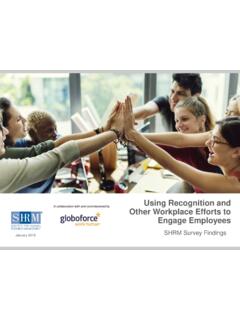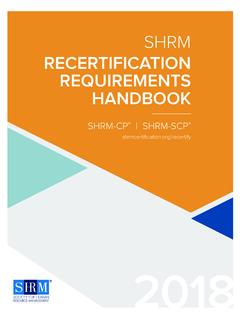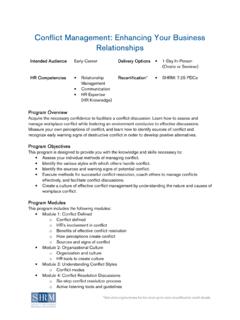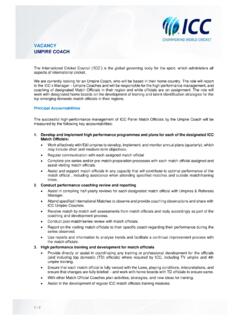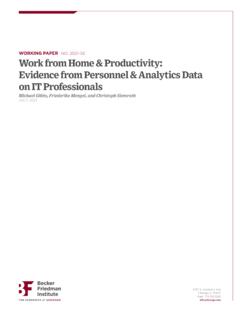Transcription of Employment Downsizing and its Alternatives
1 SHRM Foundation s Effective Practice Guidelines SeriesStrategieS for Long-term SucceSS Employment Downsizing and its AlternativesSponsored byright managementWayne F. CascioStrategieS For Long-term SuCCeSS Employment Downsizing and its AlternativesSHRM FounDAtion S EFFE ctivE PRActicE GuiDElinES SERiESSponsored by Right ManagementThis publication is designed to provide accurate and authoritative information regarding the subject matter covered. Neither the publisher nor the author is engaged in rendering legal or other professional service. If legal advice or other expert assistance is required, the services of a competent, licensed professional should be sought. Any federal and state laws discussed in this book are subject to frequent revision and interpretation by amendments or judicial revisions that may significantly affect employer or employee rights and obligations. Readers are encouraged to seek legal counsel regarding specific policies and practices in their book is published by the SHRM Foundation, an affiliate of the Society for Human Resource Management (SHRM ).
2 The interpretations, conclusions and recommendations in this book are those of the author and do not necessarily represent those of the SHRM Foundation. 2009 SHRM Foundation. All rights reserved. Printed in the United States of publication may not be reproduced, stored in a retrieval system or transmitted in whole or in part, in any form or by any means, electronic, mechanical, photocopying, recording or otherwise, without the prior written permission of the SHRM Foundation, 1800 Duke Street, Alexandria, VA SHRM Foundation is the 501(c)3 nonprofit affiliate of the Society for Human Resource Management (SHRM). The SHRM Foundation maximizes the impact of the HR profession on organizational decision-making and performance by promoting innovation, education, research and the use of research-based knowledge. The Foundation is governed by a volunteer board of directors, comprising distinguished HR aca-demic and practice leaders. Contributions to the SHRM Foundation are tax deductible.
3 Visit the Foundation online at For more information, contact the SHRM Foundation at + Downsizing and its Alternatives09-0971 contentstable of Employment Downsizing and its Alternativesv Forewordvii Acknowledgmentsix About the Author1 Employment Downsizing and Its Alternatives : Strategies for Long-Term Success 2 Why Downsizing Happens 2 When Is Downsizing the Answer And How to Do It Right 13 Alternatives to Downsizing 15 Consequences of Employment Downsizing 19 Conclusion21 Glossary of Terms23 References29 Sources and Suggested ReadingsvDear Colleague:Many organizations have faced or will face the decision to downsize their workforce. Especially in tough economic times, companies struggle with how to best manage their most valuable resource their human resources while staying viable as a business. It is this challenge that led us to prepare this Effective Practice Guidelines report, Employment Downsizing and Its Alternatives . In 2004, the SHRM Foundation developed the Effective Practice Guidelines series, a resource that we believe is one of the best available for busy HR professionals like you.
4 Recognizing that you have little time to keep up with results of academic research and let s face it, some of it is challenging to wade through as well we created this series. By integrating the latest research findings on what works and expert opinion on how to conduct effective HR practice into a single publication, we make theory and practice accessible to reports in this series, all available online, include Recruiting and Attracting Talent, Developing Leadership Talent, Retaining Talent and Human Resource Strategy. This report on Downsizing is the 10th in the series. For each report, a subject matter expert is chosen to be the author. After the initial draft is written, the report is reviewed by both academics and practitioners to ensure that the material is research-based, comprehensive and presented in an easy-to-use format. We also include a Sources and Suggested Readings section as a convenient reference tool. This series supports our vision for the SHRM Foundation to maximize the impact of the HR profession on organizational decision-making and performance by promoting innovation, education, research and the use of research-based knowledge.
5 Overall, the Foundation has a strategic focus on initiatives designed to help organizations maximize leadership talent. We are confident that the Effective Practice Guidelines series takes us one step closer to making our vision a reality. Feel free to let us know how we are doing!Mary A. Gowan, Chair, SHRM Foundation Research Applications Committee Dean and Professor of Management Elon UniversityForewordviiAcknowledgmentsThe SHRM Foundation is grateful for the assistance of the following individuals in producing this report: content editorMary A. Gowan, and Professor of Management Martha and Spencer Love School of BusinessElon UniversityreviewersDaniel C. Feldman, Dean for Research and International Programs Terry College of Business University of GeorgiaLyle S. Hanna, SPHRP resident Hanna Resource GroupMerry Lee Lison, SPHR, GPHRD irector, Human Resources TRC Global Solutions, Miller, SPHRP resident Venture HRO, LLCJ enee LeBlanc OlivierHuman Resources Director Sigma Engineers and ConstructorsProject ManagerBeth M.
6 McFarland, CAE Manager, Special Projects SHRM FoundationThis report is sponsored by Right Management. Additional funding for the Effective Practice Guidelines series is provided by the HR Certification Institute and the Society for Human Resource Management. ixAbout the Author: Wayne F. Cascio Wayne F. Cascio holds the Robert H. Reynolds Chair in Global Leadership at the University of Colorado Denver. Dr. Cascio has consulted with more than 200 organizations on six continents and is an elected Fellow of the National Academy of Human Resources, the Academy of Management and the American Psychological Association. He has authored or edited 22 books on human resource management, including Investing in People (with John Boudreau, 2008), Managing Human Resources (8th ed., 2009), Responsible Restructuring: Creative and Profitable Alternatives to Layoffs (2002) and Applied Psychology in Human Resource Management (7th ed., with Herman Aguinis, forthcoming). He is a two-time winner of the best-paper award from the Academy of Management Executive for his research on Downsizing and responsible restructuring.
7 Dr. Cascio received his in industrial and organizational psychology from the University of Rochester. He has served as president of the Society for Industrial and Organizational Psychology (1992-1993), chair of the SHRM Foundation (2007) and chair of the HR Division of the Academy of Management (1984). He was also a member of the Academy of Management s Board of Governors from 2003 to 2006. In 1999 he received the Distinguished Career award from the HR Division of the Academy of Management. Dr. Cascio received an honorary doctorate from the University of Geneva (Switzerland) in 2004, and in 2008 the Journal of Management named him one of the most influential scholars in management in the past 25 years. Currently he serves as editor of the Journal of World have tracked the performance of Downsizing firms versus nondownsizing firms for as long as nine years after a Downsizing event. The findings: As a group, the downsizers never outperform the Downsizing and Its Alternatives : Strategies for Long-Term Successemployment Downsizing and its alternativesEmployment Downsizing has become a fact of working life as companies struggle to cut costs and adapt to changing market demands.
8 But does this practice achieve the desired results? Studies have tracked the performance of Downsizing firms versus nondownsizing firms for as long as nine years after a Downsizing event. The findings: As a group, the downsizers never outperform the nondownsizers. Companies that simply reduce headcounts, without making other changes, rarely achieve the long-term success they desire. In contrast, stable employers do everything they can to retain their employees. More than three million Americans lost their jobs in 2008. However, 81 percent of the top 100 companies in Fortune s 2009 list of Best Employers to Work For had no layoffs that Downsizing is often implemented during economic downturns as a reactive, tactical action. The most successful organizations, however, use Downsizing more strategically as part of an overall workforce strategy. Layoffs become just one tool in a portfolio of Alternatives to improve firm performance. Management may view this as an opportunity to enhance the organization s medium- and long-term agility through well-planned and targeted coaching , change and career-management Systems, a company that has changed its workforce strategy in recent years, laid off 20 percent of its workforce in 2001 due to tough times.
9 In 2008, the firm implemented Employment Downsizing only as a last resort, after deploying several other Alternatives . The new, measured approach was more consistent with Cisco s long-term talent management strategy of building internal talent rather than buying it in the external labor This report will explore why Downsizing happens and how to do it right. It will also address the Alternatives to Downsizing and the consequences of a downsized workforce. 2employment Downsizing and its alternativesWhy Downsizing Happens Firms all over the world undertake Downsizing with the expectation that they will achieve economic benefits. The belief that there are only two ways to make money in business cutting costs or increasing revenues leads to this expectation. Anyone who pays a mortgage knows that future costs are more predictable than future revenues. Payroll expenses are fixed costs, so by cutting payroll other things remaining equal firms should reduce expenses. Reduced expenses translate into increased earnings.
10 Earnings drive stock prices higher, and this makes investors and analysts happy. The key phrase above is other things remaining equal. Many organizations define workers only in terms of how much they cost and fail to consider the value they create. For this reason, other things often do not remain equal, so many of the anticipated benefits of Employment Downsizing do not addition to a smaller payroll, a downsized organization often means: Lost business as a result of fewer salespeople. Lack of new products since there are fewer R&D staff members. Reduced productivity when high performers leave as morale missed opportunities resulting from Downsizing can have a huge negative impact on the fortunes of an organization. Beyond missed opportunities, large layoffs tend to result in a substantial decline in employee morale and commitment and a significant increase in And for the bottom line, research indicates that companies with very deep layoffs underperform the market by as much as eight percent over the ensuing three why are firms still resorting to layoffs?
